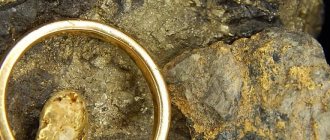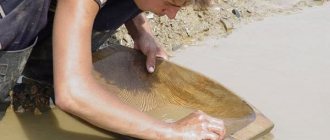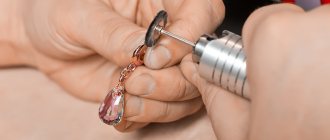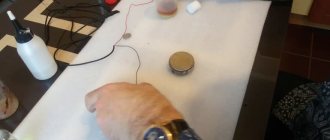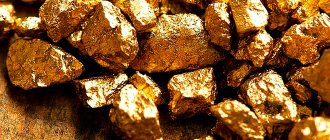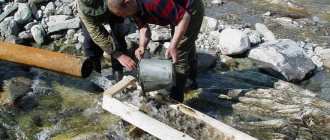The origin of gold still remains a mystery. Many scientists come to the conclusion that gold is of cosmic origin. But this theory is incomplete, since the relationship of gold to water was noted - it is at the bottom of rivers and reservoirs that the precious metal can be found. Even in sea water, gold can be found in the form of colloidal particles. How to find gold in streams and rivers is a question that worries not only scientists, but also miners who are looking for ways to get rich.
Searching for gold in the streams
Where do miners find gold in Russia?
The largest Au deposits are located in the Far East and Eastern Siberia. The third place is occupied by the Urals.
Below is a list of rivers containing the largest reserves of the yellow metal - this is where I recommend finding and washing it.
Yellow metal satellites
Companion rocks that play the role of “witnesses”, suggesting that gold-bearing veins are somewhere nearby:
- silver;
- pyrite;
- quartz;
- lead;
- galena.
Pyrite is the most insidious companion of gold, because beginners often cannot distinguish it from a real noble metal: they find a mass of pyrite crystals and rejoice at the happiness that has fallen on their heads, and then they are disappointed.
Meanwhile, gold can not only be washed from the river, but also found inside inconspicuous-looking pieces of rock scattered along the shore. If a piece of mineral glitters with a yellow tint that does not change when light is refracted, there is most likely gold inside. This breed should be crushed and washed.
Why do they wash gold in the river?
Extracting gold from the river is the most accessible way for single miners to get hold of the precious metal. To find it in river beds and wash it out of rock, you do not need to purchase expensive equipment and hire personnel, as with industrial mining from the subsoil.
There is definitely Au in the rivers flowing near gold deposits; there is a simple popular scientific explanation for this. Temperature changes and other natural phenomena destroy gold-bearing ores, small particles of the precious metal are washed away by rain, melt and flood waters into rivers and streams. After which, being heavy, gold settles in certain places:
- terrace deposits are found on rapids and sills that rise above the level of the banks of watercourses, as well as in dry riverbeds;
- Bottom placers should be looked for in bedrock channels (in valleys);
- spit deposits are formed on river spits, whether sandy or pebbly.
It is good to find and wash small gold grains and large or small nuggets in bedrock, places where the flow of water slows down (the mouths of mountain streams, turns of riverbeds), natural “traps” (near boulders lying in a mountain river, on shallows, in pits under waterfalls, near fallen trees blocking the river flow).
Search algorithm
Stages of hunting for precious metal deposited in the river:
- Valley exploration.
- Check the current - the stronger the current, the more gold can be found in places where it slows down.
- Drawing up a route along which to search.
- Hiking along the shore, searching for satellite rocks, and with them gold itself.
Necessary tool
The equipment of a gold miner includes a metal detector (metal detector) and a mini-dredge or a tray for washing rock.
You also need full equipment for going to the area where you are going to search and mine gold.
Is it possible to mine gold in Russia?
Until 2021, only large legal entities had the right to engage in gold mining. The activities of private miners who dared to wash the precious metal were completely illegal and criminally punishable.
Currently, private individuals have the right to extract gold from deposits - under two conditions:
- individual entrepreneur registration;
- availability of a license or agreement with a gold mining organization that has all the permits for the development of gold mines.
Obtaining a license is a long and troublesome procedure; concluding an agreement with a licensed gold mining company is a much simpler path.
Industrial mining of precious metals brings companies quite high incomes. And private miners who want to pan for gold using the artisanal method are not competitors for them. So we can reach an agreement.
What laws regulate gold mining?
Business entities have the right to engage in gold mining in the Russian Federation, guided by the federal law “On Subsoil”, after the adoption of a number of amendments allowing both legal entities and individual entrepreneurs to mine gold from the beginning of 2021. Any private miner is given the opportunity to rent a plot of land of up to 0.15 square meters for a specified period, which is enough to extract up to 10 kilograms of precious metal.
A few more conditions must be met:
- obtain metal only by surface method;
- exclude the use of explosives;
- take soil only up to 5 meters deep.
If you wash precious metals without a license or an agreement with a company that has one, this activity is still punishable under Art. 191 of the Criminal Code of the Russian Federation. And violation of these requirements threatens with serious sanctions.
Permitted Miner's Tools
Tools that help you find and wash precious metals:
- Mini-drag for pumping rock from the bottom of the river (no deeper than 5 m) and washing it away.
- A tray in which it is convenient to wash the rock by hand.
- A metal detector that detects the presence of metal in the soil. A conventional device reacts not only to gold, but also to any metal, so I advise you to use a special metal detector with a sensor that can be easily configured specifically to search for gold.
What is a tray and why do you need a magnet?
A tray is a special device for washing rock and separating Au from it. With it you can do without a mini-dredge and get soil out of the river with an ordinary shovel.
The magnet helps separate black sand from base metals from Au.
In addition to the tray and magnet, I advise you to purchase a bulb bottle, which helps you easily remove precious particles from the tray at the last step of lathering.
It is more convenient to place gold grains in a glass bottle.
Necessary equipment
To search for gold on the beach or in a recreation area, all you need is a powerful flashlight , a metal scoop and a beach rake.
Special devices will also come in handy if you plan to search for and dig for gold in the ground: a magnet and a detector.
In the sea or lake, at a depth of more than 1.5 meters, you may need a diving mask .
Search by rake
They are made from ordinary country rakes. Three parallel grooves are cut into the teeth using a grinder.
Strengthen between the teeth:
- self-tapping screws slightly shorter than the teeth;
- fishing hooks.
This design firmly clings to chains, rings, earrings and other objects in the sand, holding them firmly.
The rake can be used both in the sand and under water, walking along the bottom of the coastal zone.
When working with rakes in water, be prepared to clean them after each use , because they will bring in a lot of debris and plants.
It’s good if the device has a long handle - this will greatly increase the chances of success.
Using Magnets and Detectors
Search magnets and metal detectors help make your search more effective. Digging for gold in the ground without them is completely impossible, because you need to know where to dig . Finding gold in the ground without a metal detector is possible only by accident.
Gold, being a diamagnetic material, cannot be detected by an ordinary magnet .
A powerful search magnet detects and holds gold jewelry that contains an alloy - an admixture of metals that gives strength to gold that is too soft and ductile.
Rings, rings, bracelets, hair clips, cufflinks and other jewelry are made from ligature gold. If the alloy component is nickel, then a neodymium magnet will easily find such gold. A neodymium magnet can be bought in Russian stores at a price of 1000 rubles.
You can also choose a metal detector in a store according to your financial capabilities, starting from two thousand rubles:
- Dart ─ F100 ─ waterproof metal detector, price ─ 6900 rubles.
- AQUAmarine 100 ─ underwater metal detector, price ─ 5,000 rubles.
- Minelab GOLD MONSTER 1000 is a highly efficient, powerful detector, price ─ 59,990 rubles.
- SHRXY GP-PINPOINTING is a compact detector (pinpointer) for beginners. The search depth is small ─ 5 cm, but it has high accuracy, it easily detects small metal objects in the ground layer, price ─ 2000 rubles.
How to properly wash gold with a tray
Now that we've sorted out the tools, I'll describe the technology for panning gold by hand.
It consists of three washing stages:
- large rocks and dirt;
- gravel and ordinary sand;
- black sand.
Washing away dirt and large rocks
- Fill the tray three-quarters full with rock, dip it into the stream so that the edges are above the surface of the water.
- Shake the tray back and forth and left and right, sharply but gently, without shaking out the gravel.
- After several shakes, we rotate the tray, moving the gravel in a circle, while most of the dirt inside dissolves.
- We remove the moss and roots and rub them over the tray with our fingers, checking to see if there are any gold particles in them.
- We take out large stones and check if they are washed.
We continue to wash with shaking and circular movements until large rocks and dirt are removed.
Washing out sand and gravel
- Holding the tray above the water surface, tilt it slightly away from you.
- We rotate it, shaking it from time to time in an upward motion, as if tossing a steak in a frying pan, but without throwing out the gravel and not letting it wash over the edge.
- Shake the tray (still in water) back and forth.
- Repeat steps 1-3 to thoroughly rinse the contents of the tray until only heavy rock remains at the bottom.
It consists of black sand, which, if the miner is lucky, contains grains of gold.
Washing out black sand
- We take the tray out of the watercourse. We do not pour out the water remaining at the bottom; it will be useful at the last stage of washing.
- We tilt the tray a little and slowly turn it in a circle, checking if there are any precious pieces of gold or small nuggets at the bottom. If there is any, remove it and put it in a container for storing the “catch”.
- Slowly pass a magnet over the black sand. Black sand sticks to it, separating from the golden grains.
- We take a pear bottle, squeeze it and, unclenching it, suck up the gold and water from the tray.
- Pour the remaining black sand and gold grains into a container for precious metal.
You can finish washing and cleaning black sand, extracting the smallest Au particles from it, at home.
Necessary tool
Attentiveness, geological knowledge and a metal detector can help in the search. This equipment is quite expensive and will quickly pay for itself, but not all models will cope with the task. Moreover, you need to know how to use and set up a metal detector, since it is very sensitive to the soil, which itself will create interference. The metal detector detects large nuggets at shallow depths (up to 1 m), and the smallest ones at a depth of up to 15 cm.
A special feature of working with such products is its excessive sensitivity, which is caused by a large amount of minerals and iron in the soil. The device should not be configured for a specific type of metal; it must be operated in the mode of detecting all metals without exception. Iron, like gold, produces the same sound, so it is better to stop and test the ground rather than continue searching for gold to no avail. It is necessary to listen to the soil using headphones, so you should be extremely attentive to changes in noise.
The number of false signals coming from the ground depends on the sensitivity level setting. When the sensitivity of the metal detector is low, a person hears deeper sounds of ground testing. The result of the work also depends on the ground balance setting. Ideally, the headphones will display background noise as the metal detector probes the soil, the sound may decrease or increase.
To adjust, you need to turn the knob responsible for ground balance. Every 5-7 m you will have to adjust this function, since the mineralization of the soil may be different. To search for large-sized gold on fairly strong mineralized soil, it is necessary to use a negative setting, which will reduce the sensitivity of the metal detector to small nuggets. And, conversely, when searching for small nuggets, the adjustment is made in a positive direction. The best tuning method is a small sample of gold or lead.
When listening to the soil, the metal detector coil should be kept as close to the surface as possible. When a signal occurs, listening is carried out in all directions from the possible location of the nugget. If gold is present, the signal will be heard in all directions, and if the signal is only triggered in a certain direction, then it is not gold. The last step of the test will be to raise the coil above the intended location. If the sound suddenly fades away, it means the signal is false, and this place does not even contain metal.
Choosing a place to wash gold
Tips on how to choose the best place to extract the richest rock from the water and wash the yellow metal with the greatest benefit:
- Search on a river or in a stream from the list of the most “gold-bearing” ones, not far from the place of industrial mining - after it, not only the smallest grains of gold remain, but also whole nuggets, which are enough for everyone.
- Choose a section of the watercourse with a depth of more than 15 centimeters so as not to wash the metal in too dirty water full of small debris.
- Choose a section of the river with a relatively slow (slow) flow.
- If you're lucky, find a place with a large stone or a fallen tree where you can sit down so as not to wash the precious metal while standing.
Extraction technologies
There are fewer deposits and they are being depleted. Therefore, the ability to separate gold from ore is especially valued. Here is a list of the best techniques:
- amalgamation;
- heap leaching;
- etching.
Methods for extracting gold from river beds
The sifting and washing method involves passing river sand through a sieve, tray or burlap by hand. Only Au particles larger than a grain of sand remain in the dish.
Mechanisms - dredgers, pumps, screens - dig the mass from the bottom, deliver it to the shore and quickly process it, sifting out the excess. At the same time, the amount of manual labor and the time spent on it are reduced.
Top 10 Russian rivers rich in gold reserves
The Golden Ten watercourses, where there are a lot of reserves and it’s profitable to wash:
- Alekseevsky stream (Kamchatka);
- Bodaibo River (Irkutsk region);
- tributary Bolshoi Chanchik (ibid.);
- Bom River (Amur region);
- Jalon stream (ibid.);
- the Lena River and its basin;
- Millionny stream (Amur region);
- Unakha River (ibid.);
- Sanarka River (Chelyabinsk region);
- Talga River (Khabarovsk Territory);
At Bodaibo and Millionnoye they wash the rock and extract the largest gold particles. Nuggets are also found in these and other watercourses.
A little history
If we go back to the times of Ancient Rus', it is reliably known that lands containing gold were not discovered at that time, even despite the fact that the territory of the state was quite vast. Ruler Ivan III was obsessed with the goal of finding the noble metal and even invited specialists from distant Italy for this purpose. But to his regret, only a small piece of gold was found, which was only enough to make a small cross.
The next seeker was Ivan the Terrible. For the sake of gold, he even conquered Siberia with the help of a huge army, but he never achieved the expected result. The same fate befell all the other rulers of Ancient Rus'. But the turning point in the history of gold mining was the coming to power of Peter I. It was under the power of this ruler that the first items of clothing and jewelry that contained gold and precious stones began to appear.
The first gold nugget was mined in 1945 by a Russian peasant from the Urals who was building a house on the river bank.
While digging a hole, he found golden grains of sand. The peasant immediately showed the find to his friend, who was also a silversmith. The master confirmed that the nugget was genuine. Experts arrived at the place where the grains of sand were found and began further searches. But unfortunately, they left with nothing. And only two years after the discovery of the deposit, a decision was made according to which it was necessary to continue the search and dig a mine. This decision turned out to be more than successful.
At the bottom of the dug shaft, a large amount of gold reserves were found, which marked the beginning of larger-scale mining of the metal.
Formation of deposits
Reluctantly entering into chemical reactions with other substances, this element (Au), without decaying or dissolving, sinks lower and lower into the bowels of the earth, since it has a high specific gravity. There it concentrates, forming deposits of gold-bearing rocks, from where it is mined on an industrial scale.
But, if this metal had only fallen down, it would have long since disappeared from the surface of the earth. And we would only know from films how artisanal miners pan for gold. The processes occurring in the depths are accompanied by the movement of underground water, gases, magma, the movement of layers, which carry along gold particles, pushing them back to the surface of the earth.
If gold-bearing sands were once found in rivers somewhere, it means that they could appear here tomorrow or in 10 years, obeying the same process occurring in the depths of the earth. Thus, from underground, primary (ore) deposits, surface or secondary (placer) deposits are formed.
